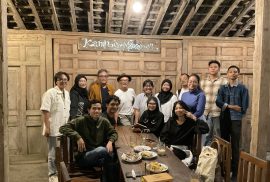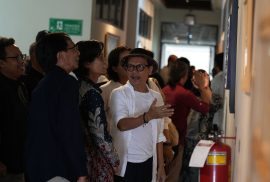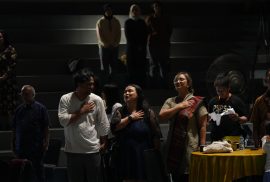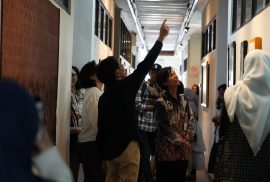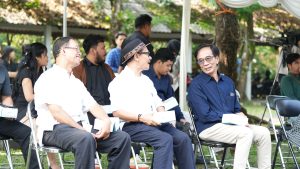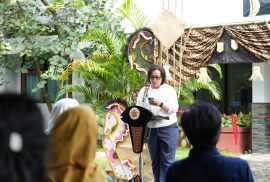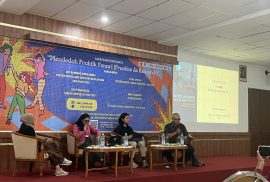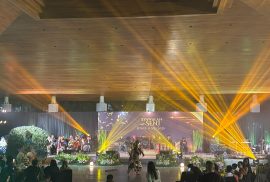On Wednesday, May 21, 2025, a field study program was conducted by the Visual Arts, Design, and Media Arts Criticism course, mentored by Dr. Suwarno Wisetrotomo. The activity took place at the Jogja Art+Books Festival 2025 (JABFEST), located at The Ratan, Jalan Ringroad Selatan No. 93, Panggungharjo, Sewon, Bantul, Yogyakarta. This year, JABFEST adopted the theme “Kereta Api yang Berangkat Pagi Hari: 82 Tahun Kuntowijoyo” (The Train Departing in the Morning: 82 Years of Kuntowijoyo). The festival featured various programs, including art exhibitions, book discussions, artist talks, a book bazaar, and other related events.
News
The opening of the Re.uni(que): Weaving Charms, Knitting Encounters exhibition and Syawalan Seni on Thursday, 8 May 2025, at the UGM Graduate School Building, highlighted the active role of students from the Performing Arts and Visual Arts Studies Program (PSPSR), Universitas Gadjah Mada (UGM). This event was part of the 34th anniversary of PSPSR and the commemoration of Dr. Gabriel Roosmargo Lono Lastoro Simatupang, M.A.’s 36 years of academic dedication.
PSPSR students from both master’s and doctoral levels were intensively involved in the preparation and execution of the event. In the week leading up to the opening, students worked together as committee members, taking responsibility for exhibition layout, artwork installation, logistics, guest management, and documentation. This collaboration strengthened student solidarity and provided valuable experience in art event management.
The Performing Enchantment event on May 9, 2025, at Gelanggang Inovasi dan Kreativitas UGM was not only a showcase of artistic excellence, but also a night filled with deep emotional resonance for the audience.
From the opening Reog Ponorogo performance, the audience was immediately captivated. Cheers and applause filled the hall as dynamic movements and spirited music set the tone for the evening.
“The energy was contagious. I was drawn into the atmosphere from the very beginning,” said Febry Anugerah, one of the audience members.
The Performing Enchantment event on May 9, 2025, at Gelanggang Inovasi dan Kreativitas UGM became a vibrant stage for celebrating Indonesia’s cultural diversity. an event held by the Graduate Program in Performing Arts and Visual Arts Studies (PSPSR) UGM, the event showcased the rich traditions of various regions, uniting different identities in a night full of harmony.
From the outset, the audience was greeted by the grandeur of Reog Ponorogo, an energetic cultural icon from East Java. The atmosphere then shifted to a solemn mood during the Batak thanksgiving ritual, Manjalo Tuani Gondang, performed meaningfully by Dr. Lono Simatupang and his family. This Batak tradition, rich in family values and gratitude, demonstrated how performing arts can bridge cultures.
A warm and enthusiastic atmosphere filled the UGM Graduate School Building on May 8, 2025, as the Performing Arts and Visual Arts Studies (PSPSR) Universitas Gadjah Mada (UGM) officially opened the Re.uni(que): Weaving Charms, Knitting Encounters exhibition. The visual documentation on this first day captured important moments, interactions, and expressions from participants and guests in this celebration of art and togetherness.
The morning began with a coffee morning session, providing a warm space for guests, students, lecturers, alumni, and artists to greet each other and share stories. The camera captured the friendly atmosphere, cups of coffee, and laughter that marked the meaningful start of the day.
Yogyakarta, May 8, 2025 – The Performing Arts and Visual Arts Studies Program (PSPSR), Universitas Gadjah Mada (UGM), officially opened the Re.uni(que): Menganyam Pesona, Merajut Perjumpaan. at the UGM Graduate School Building. This event brought together students, alumni, and lecturers, highlighting PSPSR’s commitment to the Sustainable Development Goals (SDGs) through art and intergenerational collaboration.
Dr. Nadiyah Tunnikmah, M.A., as the curator, emphasized that the exhibition was not merely about displaying artworks, but about creating a space for dialogue and social reflection. “Each piece was selected to represent the collective journey of the PSPSR community. We want visitors to experience the meaning of encounters, collaboration, and diversity, which are the strengths of art and support the inclusivity principle of the SDGs,” Dr. Nadiyah explained.
Performing Arts and Visual Arts Studies (PSPSR) Program, the Graduate School of Universitas Gadjah Mada, hosted a sharing session titled “Research Methods (in the Study of) the Arts,” featuring Michael HB Raditya, M.A., Ph.D (cand.) as the speaker. The event took place on Tuesday, May 6, 2025, at Room 407, 4th Floor, Graduate School UGM, starting at 9:00 AM.
Currently pursuing his doctoral studies at the University of Melbourne, Michael HB Raditya discussed methodological shifts in arts research, drawing from his ongoing study on dangdut, an Indonesian popular music genre. He highlighted the increasing role of digital technology and the internet in shaping contemporary research practices, especially through the use of big data and internet-based data collection.
On April 23, 2025, an engaging academic discussion was held by Taman Budaya Yogyakarta, titled “Unpacking the Dancer’s Body (Practice as Research/PaR)”. The event featured several notable speakers, including Dr. Bambang Pujasworo, a faculty member of the Graduate Program in Performing Arts and Visual Arts Studies (PSPSR) UGM, Galih Prakasiwi, M.A., an alumnus of PSPSR UGM who served as the main discussant, and Heni Siswantari, S.Pd., M.A., a Ph.D. candidate at PSPSR UGM, who acted as the moderator.
On May 9, 2025, the Graduate Program in Performing and Visual Arts Studies (PSPSR) at Universitas Gadjah Mada (UGM) held Performing Enchantment at the Gelanggang Inovasi dan Kreativitas UGM, presenting a rich evening of diverse expressions in the performing arts.
From the outset, the spatial arrangement stood out. Instead of using the conventional stage, the performance area was placed in front of it, giving performers the freedom to move and create dynamic floor patterns. The Reog Ponorogo musicians were positioned beneath the left-side stands, near the entrance and the audience, producing a surround sound effect that felt immersive and immediate.
On May 9, 2025, the Performing Arts and Visual Arts Studies Program (PSPSR) at Universitas Gadjah Mada (UGM) showcased the power of artistic collaboration at the Performing Enchantment event, held at the Gelanggang Inovasi dan Kreativitas UGM. The event was the culmination of a series of celebrations marking 36 years of Lono Simatupang’s academic contributions and 34 years of the PSPSR Program at UGM.
The event’s core was its seamless collaboration among artists, academics, alumni, students, and families. The opening Reog Ponorogo performance set the tone, bringing together local Reog artists and PSPSR’s creative team to blend tradition with fresh artistic direction.

